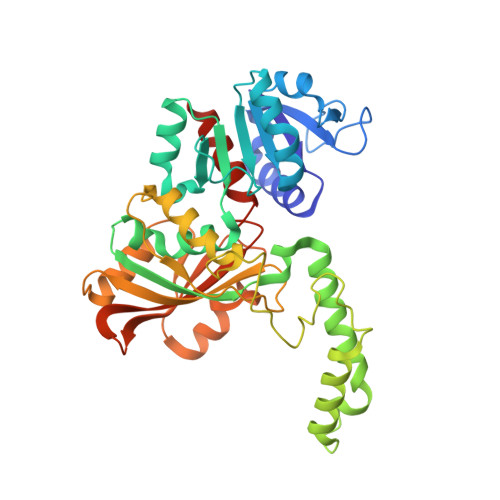A cautionary tale of structure-guided inhibitor development against an essential enzyme in the aspartate-biosynthetic pathway.
Pavlovsky, A.G., Thangavelu, B., Bhansali, P., Viola, R.E.(2014) Acta Crystallogr D Biol Crystallogr 70: 3244-3252
- PubMed: 25478842
- DOI: https://doi.org/10.1107/S1399004714023979
- Primary Citation of Related Structures:
4R3N, 4R3W, 4R41, 4R4J, 4R51, 4R54, 4R5H, 4R5M - PubMed Abstract:
The aspartate pathway is essential for the production of the amino acids required for protein synthesis and of the metabolites needed in bacterial development. This pathway also leads to the production of several classes of quorum-sensing molecules that can trigger virulence in certain microorganisms. The second enzyme in this pathway, aspartate β-semialdehyde dehydrogenase (ASADH), is absolutely required for bacterial survival and has been targeted for the design of selective inhibitors. Fragment-library screening has identified a new set of inhibitors that, while they do not resemble the substrates for this reaction, have been shown to bind at the active site of ASADH. Structure-guided development of these lead compounds has produced moderate inhibitors of the target enzyme, with some selectivity observed between the Gram-negative and Gram-positive orthologs of ASADH. However, many of these inhibitor analogs and derivatives have not yet achieved the expected enhanced affinity. Structural characterization of these enzyme-inhibitor complexes has provided detailed explanations for the barriers that interfere with optimal binding. Despite binding in the same active-site region, significant changes are observed in the orientation of these bound inhibitors that are caused by relatively modest structural alterations. Taken together, these studies present a cautionary tale for issues that can arise in the systematic approach to the modification of lead compounds that are being used to develop potent inhibitors.
Organizational Affiliation:
Department of Chemistry and Biochemistry, The University of Toledo, Toledo, OH 43606, USA.

















